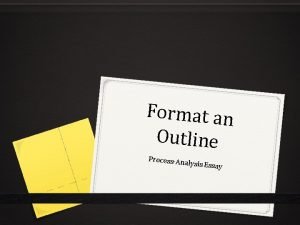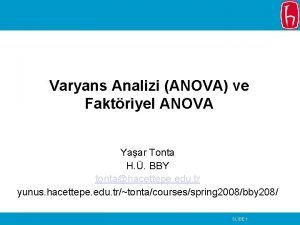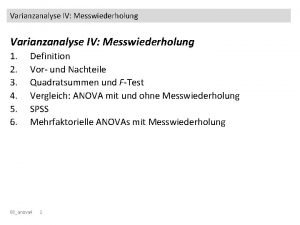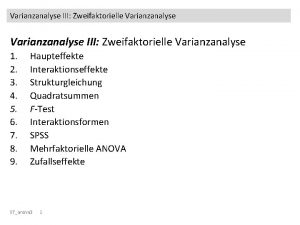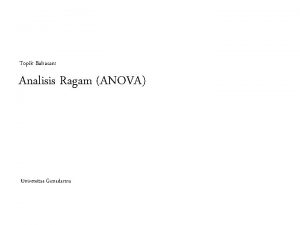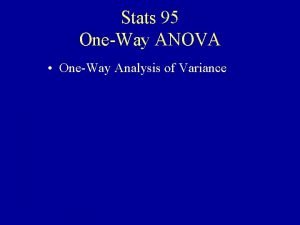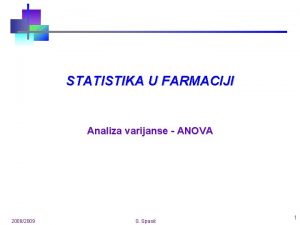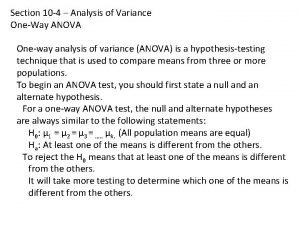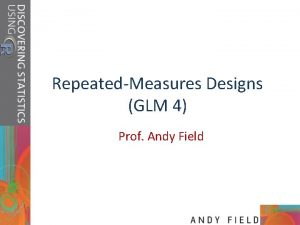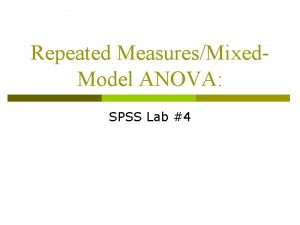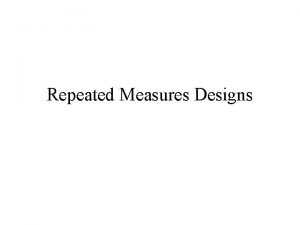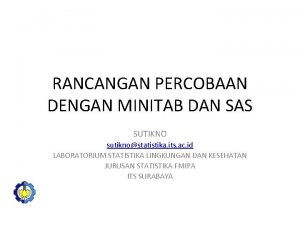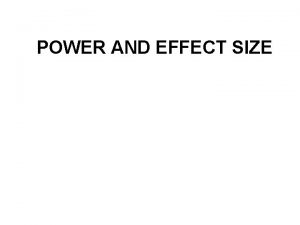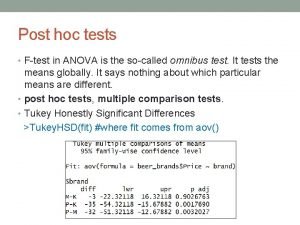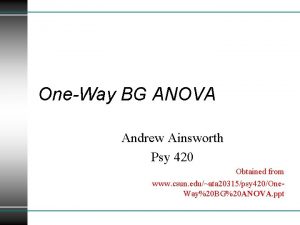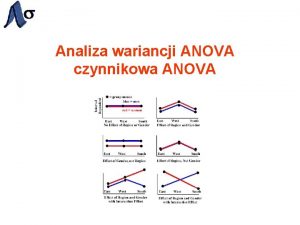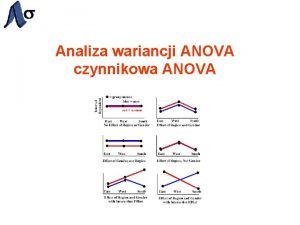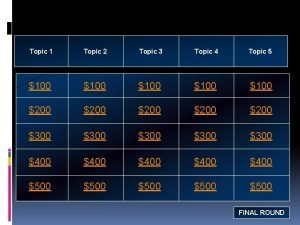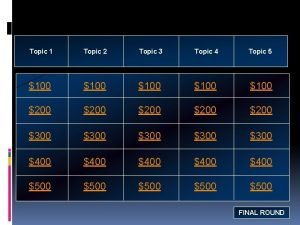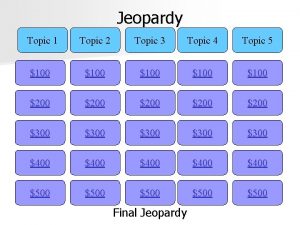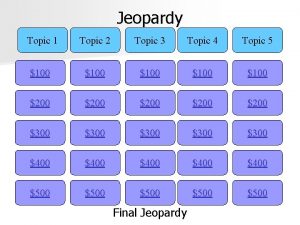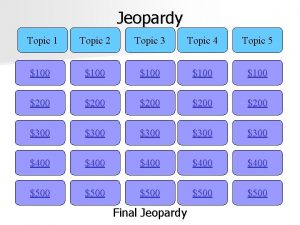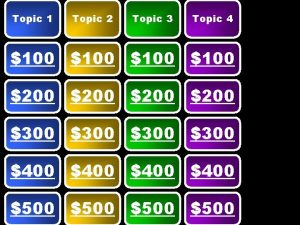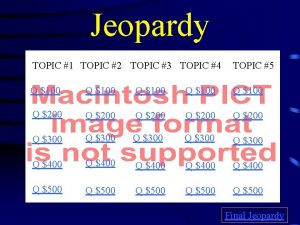Topic 29 ThreeWay ANOVA Outline Threeway ANOVA Data



































- Slides: 35

Topic 29: Three-Way ANOVA

Outline • Three-way ANOVA – Data – Model – Inference

Data for three-way ANOVA • • Y, the response variable Factor A with levels i = 1 to a Factor B with levels j = 1 to b Factor C with levels k = 1 to c • Yijkl is the lth observation in cell (i, j, k), l = 1 to nijk • A balanced design has nijk=n

KNNL Example • KNNL p 1005 • Y is exercise tolerance, minutes until fatigue on a bicycle test • A is gender, a=2 levels: male, female • B is percent body fat, b=2 levels: high, low • C is smoking history, c=2 levels: light, heavy • n=3 persons aged 25 -35 per (i, j, k) cell

Read and check the data a 1; infile 'c: . . . CH 24 TA 04. txt'; input extol gender fat smoke; proc print data=a 1; run;

Obs extol 1 24. 1 2 29. 2 3 24. 6 4 20. 0 5 21. 9 6 17. 6 7 14. 6 8 15. 3 9 12. 3 10 16. 1 11 9. 3 12 10. 8 13 17. 6. . . 24 6. 1 gender 1 1 1 2 2 2 1 2 fat 1 1 1 2 2 2 1 smoke 1 1 1 2 2 2

Define variable for a plot data a 1; set a 1; if (gender eq 1)*(fat then gfs='1_Mfs'; if (gender eq 1)*(fat then gfs='2_MFs'; if (gender eq 1)*(fat then gfs='3_Mf. S'; if (gender eq 1)*(fat then gfs='4_MFS'; if (gender eq 2)*(fat then gfs='5_Ffs'; if (gender eq 2)*(fat then gfs='6_FFs'; if (gender eq 2)*(fat then gfs='7_Ff. S'; if (gender eq 2)*(fat then gfs='8_FFS'; run; eq 1)*(smoke eq 1) eq 2)*(smoke eq 1)*(smoke eq 2)*(smoke eq 2)

Obs 1 2 3 4 5 6 7 8 9 10 11 12 extol 24. 1 29. 2 24. 6 17. 6 18. 8 23. 2 14. 6 15. 3 12. 3 14. 9 20. 4 12. 8 gender fat smoke 1 1 1 1 1 2 2 2 1 1 1 2 2 2 gfs 1_Mfs 3_Mf. S 2_MFs 4_MFS

Plot the data title 1 'Plot of the data'; symbol 1 v=circle i=none c=black; proc gplot data=a 1; plot extol*gfs/frame; run;


Find the means proc sort data=a 1; by gender fat smoke; proc means data=a 1; output out=a 2 mean=avextol; by gender fat smoke;

Define fat*smoke data a 2; set a 2; if (fat eq 1)*(smoke then fs='1_fs'; if (fat eq 1)*(smoke then fs='2_f. S'; if (fat eq 2)*(smoke then fs='3_Fs'; if (fat eq 2)*(smoke then fs='4_FS'; eq 1) eq 2)

Obs gen fat 1 2 3 4 5 6 7 8 1 2 1 2 1 1 2 2 smoke FR 1 1 2 2 3 3 3 3 avextol fs 25. 97 19. 83 19. 87 12. 13 14. 07 12. 07 16. 03 10. 20 1_fs 2_f. S 3_Fs 4_FS

Plot the means proc sort data=a 2; by fs; title 1 'Plot of the means'; symbol 1 v='M' i=join c=black; symbol 2 v='F' i=join c=black; proc gplot data=a 2; plot avextol*fs=gender/frame; run;


Cell means model • Yijkl = μijk + εijkl – where μijk is theoretical mean or expected value of all observations in cell (i, j, k) – the εijkl are iid N(0, σ2) – Yijkl ~ N(μijk, σ2), independent

Estimates • Estimate μijk by the mean of the observations in cell (i, j, k), • = (Σk. Yijkl)/nijk • For each (i, j, k) combination, we can get an estimate of the variance • We need to combine these to get an estimate of σ2

Pooled estimate of 2 σ • We pool the sijk 2, giving weights proportional to the df, nijk -1 • The pooled estimate is MSE=s 2 = (Σ (nijk-1)sijk 2) / (Σ(nijk-1))

Factor effects model • Model cell mean as μijk = μ + αi + βj + γk + (αβ)ij + (αγ)ik + (βγ)jk + (αβγ)ijk • μ is the overall mean • αi, βj, γk are the main effects of A, B, and C • (αβ)ij, (αγ)ik, and (βγ)jk are the two-way interactions (first-order interactions) • (αβγ)ijk is the three-way interaction (second-order interaction) • Extension of the usual constraints apply

ANOVA table • Sources of model variation are three main effects, the three two-way interactions, and the one three-way interaction • With balanced data the SS and DF add to the model SS and DF • Still have Model + Error = Total • Each effect is tested by an F statistic with MSE in the denominator

Run proc glm data=a 1; class gender fat smoke; model extol=gender fat smoke gender*fat gender*smoke fat*smoke gender*fat*smoke; means gender*fat*smoke; run;

Run proc glm data=a 1; class gender fat smoke; model extol=gender|fat|smoke; means gender*fat*smoke; run; Shorthand way to express model

SAS Parameter Estimates • Solution option on the model statement gives parameter estimates for the glm parameterization • These are as we have seen before; any main effect or interaction with a subscript of a, b, or c is zero • These reproduce the cell means in the usual way

ANOVA Table Source Model Error Sum of DF Squares Mean Square F Value Pr > F 7 588. 582917 84. 0832738 9. 01 0. 0002 16 149. 366667 9. 3354167 Corrected Total 23 737. 949583 Type I and III SS the same here

Factor effects output Source gender Type I SS Mean Square F Value Pr > F 1 176. 5837500 18. 92 0. 0005 DF fat 1 242. 57042 242. 5704167 25. 98 0. 0001 gender*fat 1 13. 650417 13. 6504167 1. 46 0. 2441 smoke 1 70. 3837500 7. 54 0. 0144 gender*smoke 1 11. 0704167 1. 19 0. 2923 fat*smoke 1 72. 4537500 7. 76 0. 0132 gender*fat*smoke 1 1. 8704167 0. 20 0. 6604

Analytical Strategy • First examine interactions…highest order to lowest order • Some options when one or more interactions are significant – Interpret the plot of means – Run analyses for each level of one factor, eg run A*B by C (lsmeans with slice option) – Run as a one-way with abc levels – Define a composite factor by combining two factors, eg AB with ab levels – Use contrasts

Analytical Strategy • Some options when no interactions are significant – Use a multiple comparison procedure for the main effects – Use contrasts – When needed, rerun without the interactions

Example Interpretation • Since there appears to be a fat by smoke interaction, let’s run a two-way ANOVA (no interaction) using the fat*smoke variable • Note that we could also use the interaction plot to describe the interaction

Run glm proc glm class model means run; data=a 1; gender fs; extol=gender fs; gender fs/tukey;

ANOVA Table Source Model Error Sum of DF Squares Mean Square F Value Pr > F 4 561. 99167 140. 4979167 15. 17 <. 0001 19 175. 95792 Corrected Total 23 737. 94958 9. 2609430

Factor effects output Mean Source DF Type I SS Square F Value Pr > F gender 1 176. 5837500 19. 07 0. 0003 fs 3 385. 40792 128. 4693056 13. 87 <. 0001 Both are significant as expected…compare means

Means for gender Mean N gender A 18. 983 12 1 B 13. 558 12 2

Tukey comparisons for fs A B B B Mean 22. 900 N 6 fs 1_fs 16. 000 6 2_f. S 13. 117 6 4_FS 13. 067 6 3_Fs

Conclusions • Gender difference with males having a roughly 5. 5 minute higher exercise tolerance – beneficial to add CI here • There was a smoking history by body fat level interaction where those who were low body fat and had a light smoking history had a significantly higher exercise tolerance than the other three groups

Last slide • Read NKNW Chapter 24 • We used program topic 29. sas to generate the output for today
 How to write a quote sandwich
How to write a quote sandwich Perbedaan anova one way dan two way
Perbedaan anova one way dan two way One way anova vs two way anova
One way anova vs two way anova Pertanyaan tentang anova
Pertanyaan tentang anova General subject example
General subject example Broad and specific topic examples
Broad and specific topic examples Topic outline
Topic outline A topic outline uses
A topic outline uses What is a topic outline
What is a topic outline Example of topic outline
Example of topic outline Digital topic outline
Digital topic outline Outline data
Outline data Grubbs test minitab
Grubbs test minitab Anova testi ne zaman kullanılır
Anova testi ne zaman kullanılır Sphärizitätsannahme
Sphärizitätsannahme Zweifaktorielle varianzanalyse
Zweifaktorielle varianzanalyse Two-way anova r
Two-way anova r Perbedaan one way dan two way anova
Perbedaan one way dan two way anova F testi hesaplama
F testi hesaplama Anova two factor with replication
Anova two factor with replication Analisis ragam anova
Analisis ragam anova One way anova table
One way anova table One way anova null hypothesis
One way anova null hypothesis Anova statistika
Anova statistika Split plot rak
Split plot rak Factorial anova
Factorial anova One-way anova
One-way anova Andy field repeated measures anova
Andy field repeated measures anova Multivariate anova spss
Multivariate anova spss Repeated measures
Repeated measures Repeated-measures design
Repeated-measures design Repeated measures anova
Repeated measures anova Yijk anova
Yijk anova Anova effect size
Anova effect size Assumption of anova
Assumption of anova Effect size omega squared
Effect size omega squared







